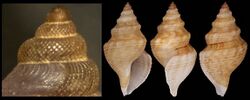Biology:Gymnobela abyssorum
| Gymnobela abyssorum | |
|---|---|

| |
| Shell of Gymnobela abyssorum | |
| Scientific classification | |
| Domain: | Eukaryota |
| Kingdom: | Animalia |
| Phylum: | Mollusca |
| Class: | Gastropoda |
| Subclass: | Caenogastropoda |
| Order: | Neogastropoda |
| Superfamily: | Conoidea |
| Family: | Raphitomidae |
| Genus: | Gymnobela |
| Species: | G. abyssorum
|
| Binomial name | |
| Gymnobela abyssorum (Locard, 1897)[1]
| |
| Synonyms[2] | |
| |
Gymnobela abyssorum is a species of sea snail, a marine gastropod mollusk in the family Raphitomidae.[2]
Description
A biconical shell up to 23mm high with 6–7 shouldered whorls. Its diameter is 10 mm. Buff in colour with brownish marks.[3]
Description. – Shell of medium size, of a slightly ovoid elongated curve, a little more developed above than below. The obtuse spire is of mediocre length. It is composed of 8 to 9 whorls growing slowly in diameter and in height. They show a slightly concave-oblique profile on almost half of the height (more than half in the upper whorls, and less than half on the penultimate whorl). Then they become almost upright or slightly convex, with a keel sensitive to the change of direction of the whorls. The body whorl measures almost two-thirds of the total length. It is a slightly concave at the top. In lateral profile, on the opposite side to the outer lip, it becomes convex, then suddenly attenuated at the base. It ends in an open wide, short and almost straight siphonal canal. The linear sutures are impressed. The small, mamillate apex is followed by 3 to 4 embryonic, well rounded and very finely decussate whorls. The aperture measures half the total length. It is subrectangular-oblique, a little more narrowed at the base, inscribed in an almost vertical plane. The peristome shows almost continuous edges. The thin and sharp outer edge is weakly projected forward, with a pleurotomoid notch at the top, perceptible though not very pronounced. Its lateral profile is as angular upwards, at the end of the keel, and then broadly convex-sloping towards the base. The columellar edge is a little arched at the top, upright towards the base where it ends pointedly. It shows in the upper part an accused callus. The solid shell is quite thick, subopaque, adorned with longitudinal ribs, decurrent cords and growth lines. It contains 18 to 19 longitudinal ribs on the penultimate whorl. These are large, rounded, spread out only on the base of whorls, mamillate at the keel, obsolete above, sometimes bifid below, slightly obliquely, very short on the body whorl, where they merge with growth lines. The decurrent striae are somewhat thin, regular, spaced, continuous, very attenuated at the top of the whorls, scarcely more marked at the base of the body whorl along the siphonal canal. The striations are strong, irregular, very wavy-flexuous. They form in the concave region of the whorls small corrugated folds, very close together. They blend in the body whorl, with the prolongation of the nodules of the keel. The color of the shell is a very light, non-glossy yellowish red, whiter on the inside.[4]
Distribution
This bathyl species (200 m to 1500 m) occurs in the Eastern Atlantic Ocean; also off the Azores in the Mediterranean Sea.
References
- ↑ Locard A. (1897–1898). Expéditions scientifiques du Travailleur et du Talisman pendant les années 1880, 1881, 1882 et 1883. Mollusques testacés.. Paris, Masson vol. 1 [1897, p. 1-516 pl. 1-22 vol. 2 [1898], p. 517-1044 pl. 23-40:]. World Register of Marine Species, Retrieved 29 March 2010.
- ↑ 2.0 2.1 Gymnobela abyssorum (Locard, 1897). Retrieved through: World Register of Marine Species on 29 March 2010.
- ↑ "Gymnobela abyssorum – NBN Atlas". https://species.nbnatlas.org/species/NHMSYS0021055770.
- ↑ Locard A. (1897–1898). Expéditions scientifiques du Travailleur et du Talisman pendant les années 1880, 1881, 1882 et 1883. Mollusques testacés. Paris, Masson. vol. 1 [1897], p. 1–516 pl. 1-22; vol. 2 [1898], p. 1–515, pl. 1-18
- Gofas, S.; Le Renard, J.; Bouchet, P. (2001). Mollusca. in: Costello, M.J. et al. (eds), European Register of Marine Species: a check-list of the marine species in Europe and a bibliography of guides to their identification. Patrimoines Naturels. 50: 180–213
- Bouchet & Warren, Revision of the North-East Atlantic bathyal and abyssal Turridae (Mollusca, Gastropoda); The Journal of Molluscan Studies, supplement 8, December 1980
- Sysoev A.V. (2014). Deep-sea fauna of European seas: An annotated species check-list of benthic invertebrates living deeper than 2000 m in the seas bordering Europe. Gastropoda. Invertebrate Zoology. Vol.11. No.1: 134–155
- Manousis, C. et al., 2018. The family Raphitomidae (Mollusca: Gastropoda: Conoidea) in the Greek Seas with the description of two new species.
External links
- Serge GOFAS, Ángel A. LUQUE, Joan Daniel OLIVER,José TEMPLADO & Alberto SERRA (2021) - The Mollusca of Galicia Bank (NE Atlantic Ocean); European Journal of Taxonomy 785: 1–114
- MNHN, Paris: Gymnobela abyssorum
- Tucker, J.K. 2004 Catalog of recent and fossil turrids (Mollusca: Gastropoda). Zootaxa 682:1–1295.
Wikidata ☰ Q3137780 entry
 |

